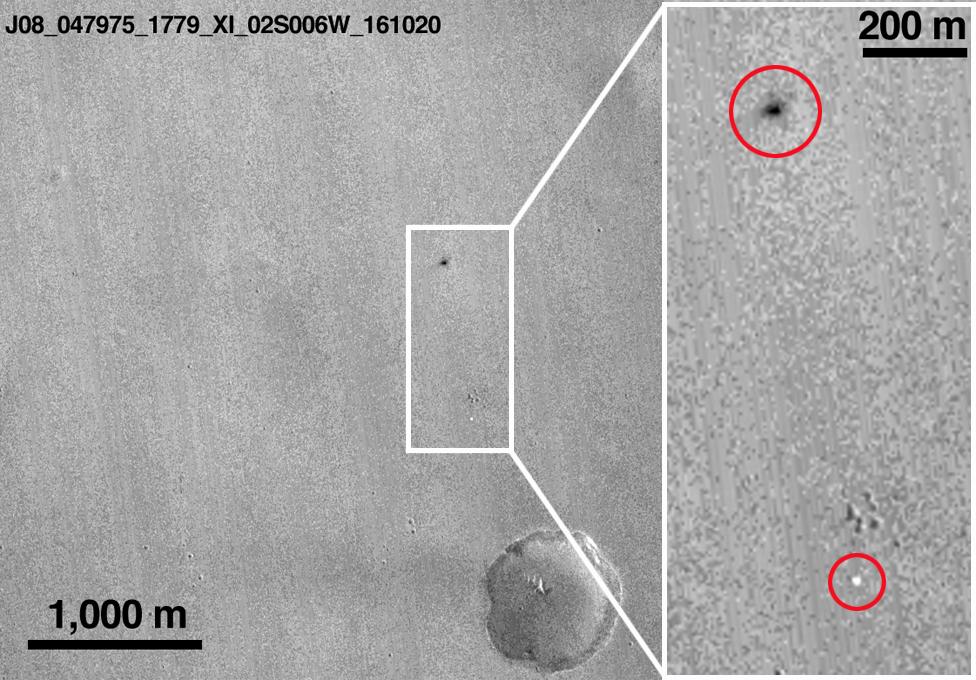Schiaparelli: Mars probe 'crash site identified'
- Published

The dark patch and white spot magnified on the right are likely the impact site and parachute
The gouge in the ground probably made by Europe's Schiaparelli probe as it hit the surface of Mars on Wednesday has been imaged by a US satellite.
The Mars Reconnaissance Orbiter (MRO) has identified a large dark patch in the robot's targeted landing zone consistent with a high-velocity impact.
Schiaparelli is widely thought to have crashed and been destroyed.
Data transmitted from the probe before it lost contact indicated that its descent systems did not work properly.
Its parachute was jettisoned too early and its retrorockets, designed to slow the robot to a hover just above the surface, fired only for a few seconds. They should have operated for half a minute.
The MRO imagery is not quite definitive because the resolution is low - just six metres per pixel. Its context is persuasive, however.
The roughly 15m by 40m dark patch, which is probably dust and rock fragments thrown out from the impact, is sited some 5.5km west of Schiaparelli's expected touchdown point in the equatorial Meridiani Plain.
Tellingly, the feature is not present in previous MRO pictures of the location.
The clincher, though, may be the artefact 1km to the south of the patch. This white blob looks to be Schiaparelli's 15m-wide parachute which would have floated down behind the probe. Again, this was not present in earlier pictures.

Artwork: Things started to go wrong at the end of the descent's parachute phase
The European Space Agency (Esa) and MRO's operator, the US space agency (Nasa), are confident the features described do indeed represent the scene of Schiaparelli's contact with the surface.
Engineers continue to analyse the telemetry the probe transmitted through the various phases of its descent before dropping radio contact unexpectedly about 50 seconds before the anticipated touchdown time.
They want to establish precisely why the parachute and rocket thrusters behaved the way they did. In due course, they hope also to be able to identify the height above the surface that each event occurred.
Ultimately, the investigation should tell us at what stage in the descent sequence Schiaparelli went into freefall - somewhere between two and four km up - and the speed with which it smacked into the ground. This is estimated to be greater than 300km/h.
Schiaparelli's landing sequence - stage by stage
Further photographic insights will come from MRO next week when it flies back over the scene with its high-resolution (HiRISE) camera.
Generally, this can distinguish objects on the ground a mere 30cm to 60cm across, and can achieve even better when special processing techniques are employed.
Schiaparelli was part of Esa's ExoMars programme - a joint venture with the Russians - which is endeavouring to search for evidence of past or present life on the Red Planet.
The 600kg robot was conceived as a technology demonstrator - a project to give Europe the learning experience and the confidence to go ahead with the landing on Mars in 2021 of an ambitious six-wheeled rover.
This future vehicle will use some of the same technology as Schiaparelli, including its doppler radar to sense the speed and distance to the surface on descent, and its guidance, navigation and control algorithms.
Esa director-general, Jan Woerner, said the fact that Schiaparelli returned 80% of its anticipated descent telemetry makes it a success, irrespective of what happened in its last seconds.
"[The 80%] means we will obtain information from a close analysis of the data that Schiaparelli was built for, notably on the performance of elements such as the heat shield, parachute, radar, thrusters and so on," he wrote on his blog, external.
"This information can subsequently be used to improve the design of the [2021] Exomars mission, since in that mission the survival of the descent module will be of real scientific relevance."

Jonathan.Amos-INTERNET@bbc.co.uk, external and follow me on Twitter: @BBCAmos, external